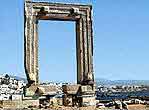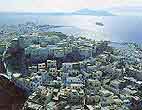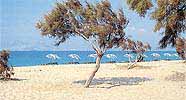 Naxos is the largest of the Cycladic islands with less of an "island" feel to it, except for its
magnificent beaches, you would say it has a pastoral, and at the same time, mountainous terrain feeling.
For a holiday spent island hopping this can be an advantage as what Naxos
has to offer is quiet different from the other islands - besides its
long sandy beaches, it also has a green and mountainous interior
with many beautiful walking areas, including a hike to the cave
where Zeus was born. Naxos combines the characteristic colors of the
Cycladic islands with a perfect climate and beautiful natural
elements.
Naxos is the largest of the Cycladic islands with less of an "island" feel to it, except for its
magnificent beaches, you would say it has a pastoral, and at the same time, mountainous terrain feeling.
For a holiday spent island hopping this can be an advantage as what Naxos
has to offer is quiet different from the other islands - besides its
long sandy beaches, it also has a green and mountainous interior
with many beautiful walking areas, including a hike to the cave
where Zeus was born. Naxos combines the characteristic colors of the
Cycladic islands with a perfect climate and beautiful natural
elements.
 Naxos is a perfect Greek island vacation, for those who love touring
and exploring. There are numerous sights to be seen, one of the most
imposing is at the entrance of the harbour. On the small island. Here
stands a marble gate, the "Portara", next to the remains of the
unfinished ancient temple of Apollo. According to tradition is was
also known as the Baths or Palace of Ariadne. A church was built
here in the Byzantine period, but it was destroyed in 1344 by the
Turkish invasion and was never rebuilt.
Naxos is a perfect Greek island vacation, for those who love touring
and exploring. There are numerous sights to be seen, one of the most
imposing is at the entrance of the harbour. On the small island. Here
stands a marble gate, the "Portara", next to the remains of the
unfinished ancient temple of Apollo. According to tradition is was
also known as the Baths or Palace of Ariadne. A church was built
here in the Byzantine period, but it was destroyed in 1344 by the
Turkish invasion and was never rebuilt.
 In Naxos town, the port and the capital of the island, you will also
find one of the most beautiful and imposing Venetian castles, the
town's most romantic location, where you can enjoy the majestic
sunset, with a view of Paros in the background. From the surrounding
walls of the castle, three gates and seven towers have been
preserved. Within the walls are the monasteries of the Ursuline, the
Kaputsino and the old Commercial School, where the Archaeological
Museum is situated. In the museum one can see significant findings
from the primary phases of the Cycladic civilization, sculptures and
Kouroi. The Byzantine and Folklore Museum is housed in a restored
tower.
In Naxos town, the port and the capital of the island, you will also
find one of the most beautiful and imposing Venetian castles, the
town's most romantic location, where you can enjoy the majestic
sunset, with a view of Paros in the background. From the surrounding
walls of the castle, three gates and seven towers have been
preserved. Within the walls are the monasteries of the Ursuline, the
Kaputsino and the old Commercial School, where the Archaeological
Museum is situated. In the museum one can see significant findings
from the primary phases of the Cycladic civilization, sculptures and
Kouroi. The Byzantine and Folklore Museum is housed in a restored
tower.
From Hora (Naxos Town) you can visit the dozens of small white churches, the monasteries and the monuments. You can visit all the villages of the island from the nearest to the most remote while enjoying the beautiful countryside, and you can see the medieval castles that have remained from the various civilizations that have flourished on the island.
In Aggidia, 2 km (1¼ miles) outside the town of Naxos, there are the remains of an ancient temple and the twin (Catholic and Orthodox) church of Agios Artemios.
Filoti with the church of Panagia (Kimisi) and the tower of Barozzi. To the south east of the village up in the mountain of Zas there is the cave of Zas or Vakhides, where according to the tradition Zeus was born.
 Near the pretty coastal village of Apolonas, on the north side of
the island is a half-finished outsize 'kouros' (statue of a youth),
dating from the 6th century BC, still lying in the marble quarry
where it was abandoned. Another such statue can be seen at Melanes.
Near the pretty coastal village of Apolonas, on the north side of
the island is a half-finished outsize 'kouros' (statue of a youth),
dating from the 6th century BC, still lying in the marble quarry
where it was abandoned. Another such statue can be seen at Melanes.
In Flerio, there is another half-finished archaic kouros also dated from the 6th century BC.
Apirathos is a mountain village with a preserved look and feel to it, the village is distinguished for its customs, the rich folk tradition and it's local handicrafts.. There are 4 small but wonderful museums, among the exhibits you can find a series of stones on which scenes from everyday life are carved (dance, hunting, animals, boats) and linear sketches.
Each year more and more tourists visit Greece and Naxos in particular, to spend a few days in this rich and versatile natural environment, in the middle of the Aegean. Naxos is famous for its vast, sandy beaches with crystal clear and clean waters.
The most beautiful, sandy beaches, are on the south western side of the island.
 They begin with Agios Prokopios, and continue with Agia
Anna, Mikri Vigla, Kastraki, Alykos, Pirgaki, and Agiassos. Being on
this south western side of Naxos they benefit from being sheltered from
the infamous "meltemi", the north winds which sweep across
the Aegean during the summer months. This happy circumstance has
assured Naxos international fame as a place for pleasant holidays, for
swimming and sea-sports.
They begin with Agios Prokopios, and continue with Agia
Anna, Mikri Vigla, Kastraki, Alykos, Pirgaki, and Agiassos. Being on
this south western side of Naxos they benefit from being sheltered from
the infamous "meltemi", the north winds which sweep across
the Aegean during the summer months. This happy circumstance has
assured Naxos international fame as a place for pleasant holidays, for
swimming and sea-sports.
 On the beaches of Agia Anna and Agios Prokopios you will find wind
and sea conditions ideal for the lesser-experienced wind surfers and
water-skiers. Water-skis and surfing equipment are available for
rent, and on Agfios Prokopius jet-skis are also available. Each
beach has tavernas, bars and cafes lined along the white, soft sand.
Across the azure blue sea both beaches also provide incredible views
of the near-by islands.
On the beaches of Agia Anna and Agios Prokopios you will find wind
and sea conditions ideal for the lesser-experienced wind surfers and
water-skiers. Water-skis and surfing equipment are available for
rent, and on Agfios Prokopius jet-skis are also available. Each
beach has tavernas, bars and cafes lined along the white, soft sand.
Across the azure blue sea both beaches also provide incredible views
of the near-by islands.
Mikri Vigia, a masterpiece of nature, is a small cape framed by two beaches: The beach to its north is called Parthena, very clear and ideal for surfing and swimming and to its south there is the white sand-beach of Sahara, about 4 km (2½ miles) long, which is a magnet for fans of sea-sports. The area of Mikri Vigla also has some traditional restaurants and bars and tavernas.
 Kastraki is the natural extension of Mikri Vigla and it starts where
Sahara beach ends. After two small wonderful sandy beaches there
extends Agali beach, which is the main beach in Kastraki and it is 3
km long. It is one of the most wonderful beaches on Naxos and in the
Mediterranean Sea. It combines blinding white sand, very clean sea
and very quiet mainland. Kastraki has some small tavernas and
appeals to the lovers of tranquility.
Kastraki is the natural extension of Mikri Vigla and it starts where
Sahara beach ends. After two small wonderful sandy beaches there
extends Agali beach, which is the main beach in Kastraki and it is 3
km long. It is one of the most wonderful beaches on Naxos and in the
Mediterranean Sea. It combines blinding white sand, very clean sea
and very quiet mainland. Kastraki has some small tavernas and
appeals to the lovers of tranquility.
Other beautiful seaside resorts on Naxos can be found in Panormos, Psili Amos, Pachia Amos, Moutsouna, Lionas and Apollonas.
